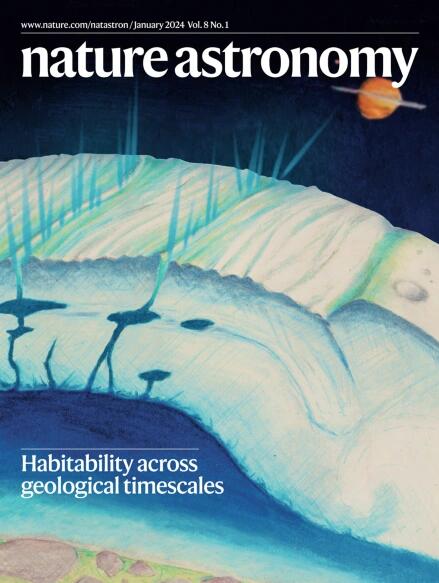生活似乎不正常
IF 14.3
1区 物理与天体物理
Q1 ASTRONOMY & ASTROPHYSICS
引用次数: 0
摘要
在另一个星球上强有力地探测到生命将是一个里程碑式的事件。一种常见的生命探测方法侧重于观察大气中与生命独特相关的关键化学物质。然而,另一种方法涉及识别化学不平衡:大气化学已经从热力学平衡被一些生物过程扰乱。Amber Young和他的同事们模拟了当今地球绕另一颗恒星运行的情况,以确定我们“不正常”的大气层是否会被JWST探测到——在某些情况下,答案是肯定的。该方法通过计算行星的有效吉布斯自由能(GFE)来建立化学不平衡,该GFE是同一系统的观测GFE与理论平衡GFE之间的差值。观测到的GFE是由观测得出的量的组合,如气体混合比、全球表面压力、有效温度以及大气中云、气溶胶和雾霾的物理性质。理论上的估计基本上是通过将行星成分放入一个“盒子”并让它们沉淀而得出的。地球大气平衡的主要“扰动”与CH4-O2系统有关,其中甲烷是新陈代谢产生的废气。JWST/MIRI无法检测到地球-太阳系统的~ 1 jmol−1 GFE偏移。然而,如果地球要凌日一颗M矮星(TRAPPIST-1类似物),如果能够达到具有挑战性的百万分之一噪声水平,就可以探测到~320 J mol−1 GFE偏移。本文章由计算机程序翻译,如有差异,请以英文原文为准。
Life might seem out of whack
求助全文
通过发布文献求助,成功后即可免费获取论文全文。
去求助
来源期刊

Nature Astronomy
Physics and Astronomy-Astronomy and Astrophysics
CiteScore
19.50
自引率
2.80%
发文量
252
期刊介绍:
Nature Astronomy, the oldest science, has played a significant role in the history of Nature. Throughout the years, pioneering discoveries such as the first quasar, exoplanet, and understanding of spiral nebulae have been reported in the journal. With the introduction of Nature Astronomy, the field now receives expanded coverage, welcoming research in astronomy, astrophysics, and planetary science. The primary objective is to encourage closer collaboration among researchers in these related areas.
Similar to other journals under the Nature brand, Nature Astronomy boasts a devoted team of professional editors, ensuring fairness and rigorous peer-review processes. The journal maintains high standards in copy-editing and production, ensuring timely publication and editorial independence.
In addition to original research, Nature Astronomy publishes a wide range of content, including Comments, Reviews, News and Views, Features, and Correspondence. This diverse collection covers various disciplines within astronomy and includes contributions from a diverse range of voices.
 求助内容:
求助内容: 应助结果提醒方式:
应助结果提醒方式:


